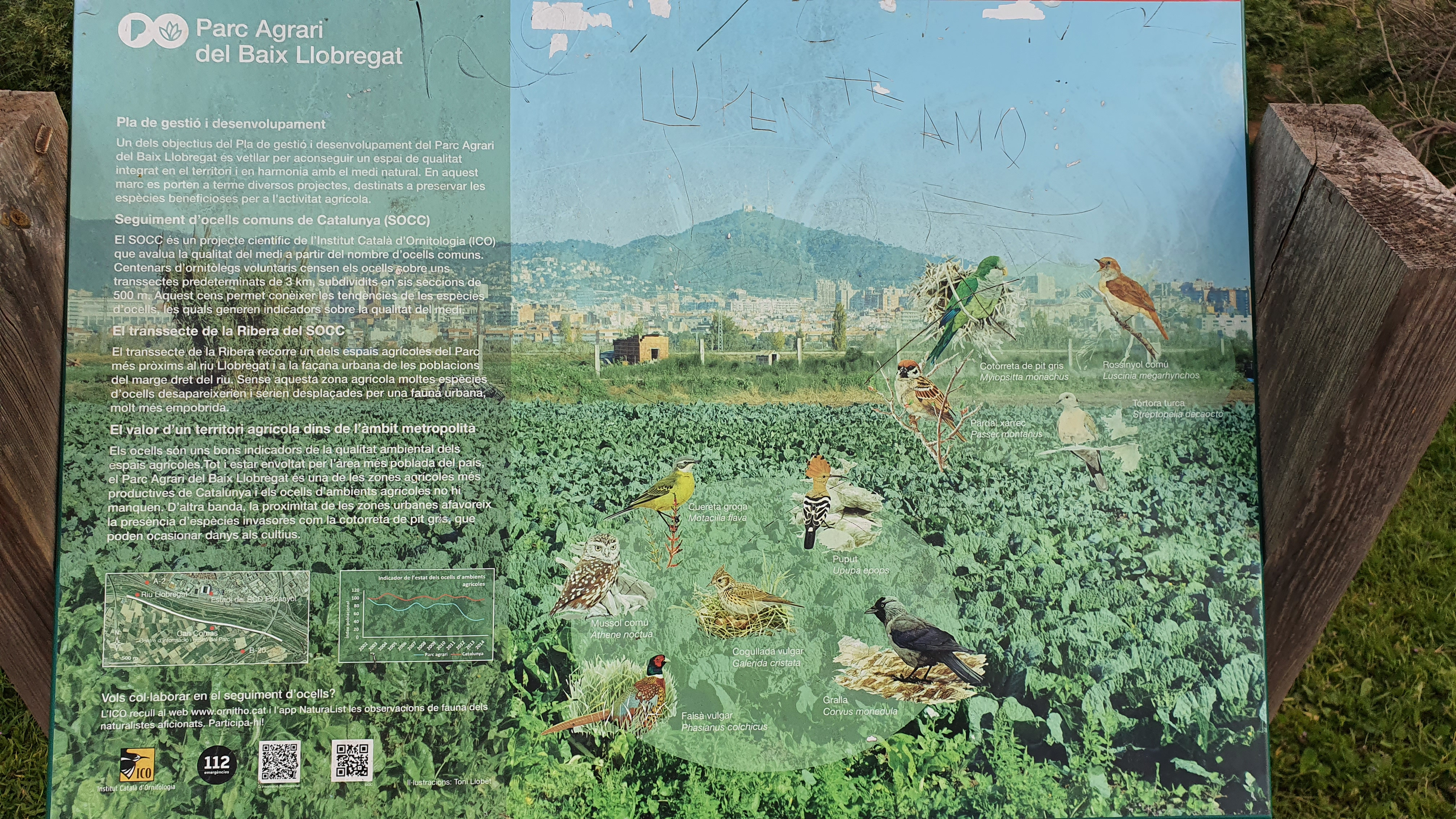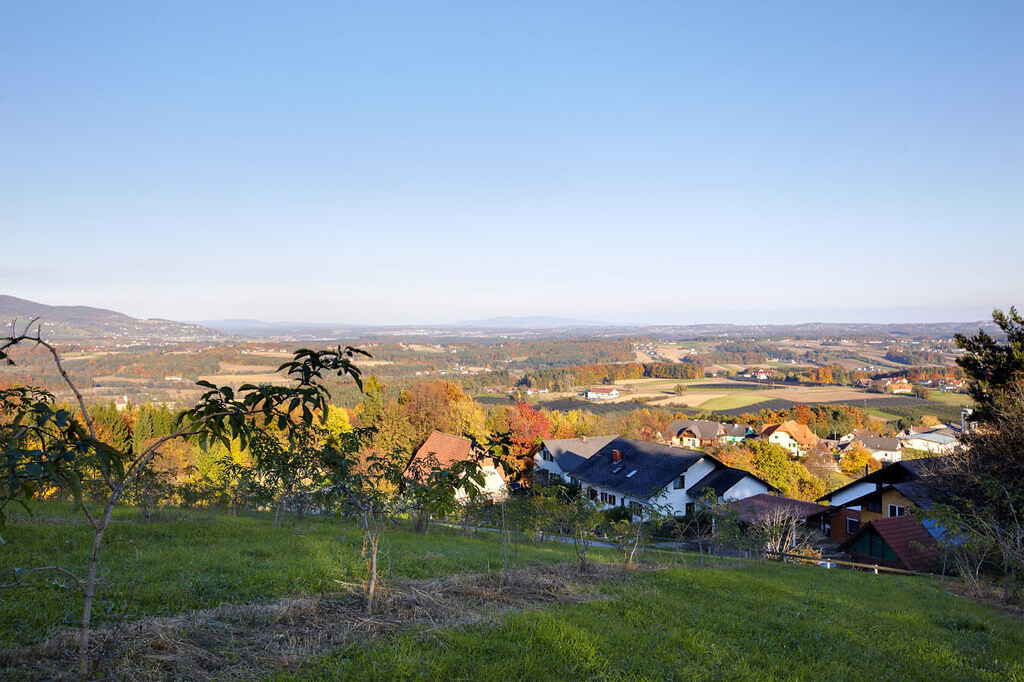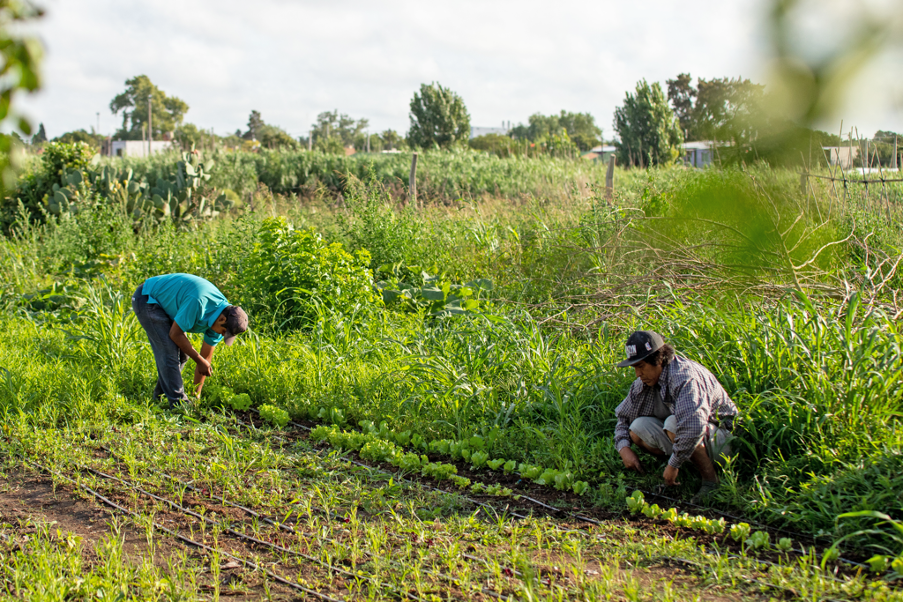The Agroecological Park seeks to regain control over the use of peri-urban land under urbanisation pressure through the creation of a dedicated territorial area (a park) where specific rules apply that create favourable circumstances for agroecological farming in close proximity to the urban area. The Agroecological Park plays an important role in the preservation and protection of territorial assets against the advance of the urban frontier and the development of large scale, export oriented, extractive forms of farming.
The Park creates favourable conditions for agroecological food growing both in terms of shared infrastructure, shared management, and technical assistance. The Park may include collective farmers operating infrastructure (such as shared storage, shared equipment, composting installations, etc.) as well as food processing and marketing facilities. The figure of the Park makes it possible to have a dedicated geographical area that can act as an incubator for specific farming models. Such dedicated areas will typically include transition measures, strategies of enrollment and an adequate timeline for traditional farmers to switch to agroecological farming or to make space for new farmers.
The establishment of a Peri-urban Agroecological Park works towards an agroecological urbanism by experimenting with intensive forms of co-production between farming actors, spatial planners, food planning departments, environmental planning agencies. It works towards the development of integrated landscapes in which farmers can take up a role as stewards of the natural resources and collective assets that secure the virtuous metabolic cycles that not only secure ecological food production but also contribute to climate regulation, biodiversity improvement, water quality, etc.
The Agroecological Park may help to define strategic actions within peri-urban contexts where land use is typically contested and subject to active transformation. The Agroecological Park structures the common ground between the interest of farmers and the multifunctional objectives of an urbanising society. Likewise the Agroecological Park may articulate the relationship between environmental goals, the development of green infrastructure and agroecological farming, building the land mosaics that combine intrinsic and functional biodiversity.
Why an Agroecological Park?
This is not an agropark
The notion of the agricultural park or agropark is well established as a strategy to facilitate agricultural economic development following a similar logic than that of industrial parks or commercial parks. The logic of the agropark does not necessarily support the development of agroecology. Quite to the contrary, Agroparks include models that in fact seek the intensification of industrial agricultural production and the promotion of cultivation models diametrically opposed to what is intended by this building block. The agroecological park seeks to reappropriate the territorial figure of the park to create a sanctuary space for agroecology.
The building block of the Agroecological Park builds on the notion of the agricultural park in the sense that it embraces the use of territorial instruments in bringing about transitioning in agricultural models, more specifically the creation of a dedicated area with special rules and regulations (i.e. the ban of pesticides), specific forms of management (i.e. installation and maintenance of shared infrastructure), and the visible implementation of distinctive farming practices (no tilling, no naked soils, elaborate crop rotation systems, companion planting and aspects of agroforestry, etc. ). It thereby sets itself apart from the traditional agropark that is mostly geared at the benefits derived from clustering intensive agricultural production, the logistic support and the related processing industries. (Smeets 2011)
It does however seek the same advantage of being able to rely on shared infrastructure and the economic benefits of proximity and co-presence in one and the same area. And, it does take inspiration of the impact that targeted public investment in the construction of favourable environments can have on farmers (Thieman 2015) by creating a context in which circumstances that are hard to create ‘on farm’ are taken care off through collective organisation at the level of the park, its landscape system and its park management.

Baix Llobregat information panel

Baix Llobregat general view

Spanish cities have been able to protect farmland on the peri-urban fringe through effective land use instruments and the establishment of so-called agricultural parks. The measures have been reasonably successful in stopping the destruction of agricultural soils (Miralles I Garcia 2015, 2020) but show mixed results when it comes to delivering a transition towards agroecological ways of farming. Many of these agricultural parks are situated within naturally sensitive areas. This provides clear opportunities to link nature development and biodiversity goals to the establishment of conditions in which only certain farming models can thrive. Agroecology can be a gamechanger in such a context, as it is a farming model that can accelerate the evolution towards nature inclusive forms of farming and move beyond the conflict between environmental goals and agricultural development. Zoning measures aimed at protecting farmland may be supplemented with legal measures to protect high valued soils, as is the case in the Parque Agrario de Fuenlabrada, near Madrid (Yacamán Ochoa, Mata Olmo, 2017). The categorization of soils goes hand in hand with the installation of farming models that start from principles of soil care and the ecological reproduction of soil fertility.
Zoning as a counterspeculative measure
It is simply impossible to farm in an urban land market. Zoning is (and remains) an effective counter speculative measure. Creating clarity about the agricultural zoning of peri-urban land can effectively stop urbanisation, but also - if maintained - ensures that land is traded in light of its use as farm land. Zoning is an effective tool to explicitly designate the valuable soils of the region for agroecological soil based farming. Such passive measures should be accompanied by active policies that stimulate the actual agroecological cultivation of these soils. Existing agroecological parks demonstrate the effective use of zoning tools, but often lack an explicit vision regarding the desired use of protected soils.

The agroecological park is a sanctuary space, shielded from the dominant context, in which other rules can be set and favorable conditions for agroecological farming created. This may come in the form of training, of specific ‘test spaces’ (as in the Pede Valley in Brussels). This may also come in the form of specific infrastructure (land readjustment, composting facilities, processing facilities, machine sharing); the building of shared management and maintenance capabilities; training and technical assistance; cancellation of unnecessary roads, land readjustment, the reintroduction of hedgerows, and other small landscape elements; water harvesting infrastructure (on and on off farm); etc. Park management may also come with shared marketing strategies, food processing and conservation, shared logistics, labeling etc. (Parc Agrari del Baix Lobregat).
Regionalism revisited
The region and various forms of regional planning have historically tried to transcend the divide between town and country planning, finding in the region a scale and territorial unit of governance that can counteract the asymmetry between urban centres and their so-called peripheries. Some of such regional planning efforts try to find in the region the means to reconnect to a ‘natural’ geography that precedes urbanisation. The origin of many of these initiatives lies in a broad spectrum of organic farming initiatives rather than agroecology per se (bioregion, bio-sovereignties…). They build on a strong connection between territorial anchoring and ambitions related to regional resource sovereignty. Political agroecology adds to such initiatives an overt and outspoken connection to the role of farmers in constructing a regionalism in which the care for the soil is rooted in the actual practice of its cultivation.

The paradigm of the eco-regione or bio-region comes with the desire to reconnect the urban agglomeration to the ‘natural’ regional geography that precedes urbanisation (foodsystemchange.org). Dynamics of urbanisation overwrite a pre-urban geography, threatening the hydrological integrity of the region, the soil structure, the nutrient cycles, the biodiversity, etc. Particularly inspiring is the way in which many eco-regional initiatives start from self-imposed ecological and territorial boundaries and re-think urbanisation as part of the care for the landed resources within the particular region.
In the German and Austrian context we can witness many Öko-region initiatives. Most of them have their origin in the promotion of organic farming (not in agroecology per se). The focus on organic farming cements the link between regional policies and soil care (ie. Ökoregion Kaindorf and the Humus+ project). Soil and farming are recognized as the necessary basis for an ecological regional geography. These initiatives do establish a strong connection between resource sovereignty and an understanding of territorial control built around place-based solidarities between actors within a region, and move well-beyond protectionist and identitarian regionalist logics. They give farmers a potential place within regional constituencies, and indirectly a place in the territorial governance of urbanisation, a place often denied to them within urban and metropolitan territorial governing bodies.
Land sharing: incorporating nature development goals within areas reserved for agricultural development
The agroecological park maps into the land sharing - land sparing debate. The agroecological park works on the sharing front. It is not intended as an alternative for exclusive reservations of valuable nature spots, but rather seeks to introduce specific forms of agricultural management in areas where only specific forms of agriculture are appropriate given the presence of important natural assets. Agroecological farming may be a game changer in such contexts as it does not pollute the water table, improves soil infiltration, improves agro-biodiversity, etc. Following this logic, the presence of specific environmental or ecological requirements may help to define and delimit specific areas of agricultural land in which only specific, agroecological forms of farming are allowed and supported.
Territorial coproduction
Area based development strategies have proven to be effective in delivering the necessary coordination of the multiple and often contested land use claims that typically coexist within urbanised areas. Such strategies have for example been successfully applied to adjust ambitions of integrated water management and urban development logics, combining challenges of flood risk, water harvesting, climate regulation, the recreational use of water, etc. within water sensitive urban development plans. The construction of integrated visions on agroecological farming lacks behind in this respect. However, area-based forms of coproduction could be equally effective in the bottom-up construction of new landscapes in which farmers are given a role as stewards of the landscape and the soils that are key to their reproduction.

In the city of Rosario, the municipal government agencies are working on a green belt policy (Cinturón Verde) within the development of current agroecological policies. The Cinturón Verde is conceived as the coordination of the efforts to promote and facilitate the transition towards agroecological production by combining multiple aspects of public policy on the largest portion(s) of farmland within the municipal boundary. The greenbelt policy is aimed at achieving favorable living and working conditions to produce agroecological food, protecting farmland from gradual conversion for other uses such as residential and industrial. The Peri-Urban Green Belt Program combines the implementation of different municipal ordinances (i.e. the prohibition of glyphosate throughout the city and of agrochemicals in the first 100 meters of the urban limit, the protection of food-growing lands (800 hectares), the obligation to incorporate food-related industries within the areas of integration with industrial zones), and active collaboration with farmers reconverting back to agroecological farming. This collaboration includes accompaniment for the remediation of upper soils, the introduction of alternative water and energy technologies, the offering of training and expert advice on agroecological cultivation and marketing. The green belt policy shows that a municipal authority can go a long way by using multiple policy instruments in a territorially coordinated manner, linking up with other organizations, institutions and neighboring municipalities.
Vision & Strategies
The idealised Agroecological park
An Agroecological Park is territorially defined. This may be in the form of a clearly demarcated territory, with clearly indicated boundaries and gateways into the Park. This may also take a more compounded form without full contiguity, bring together engaged frontrunner farms, land that has already been acquired or incorporated within an integrated form of governance, participating municipalities within a regional development scheme etc. Any of these will do as long as there is the opening to link specific areas to specific measures aimed at the introduction of or transition towards agroecological models of farming.
The Agroecological Park explicitly secures the right to farm, securing that right within a long term perspective. The Park introduces specific rules and regulations aimed at the protection of land and soil, and the tempering of urban influences that negatively affect the possibility to farm. This may include the organisation and limitation of the use of the park for recreational purposes; the integrated management of green infrastructure in which farmers or farmer collectives are given a central role; the integration of water management and cultivation strategies, etc.
The Park is an open governance coalition which maximally aims at self governance and transplants the ideals of autonomy and resource sovereignty from the territorial unit of an individual farm to a landscape level, reinserting individual farming activities within larger scale territorial entities in which nutrient cycles may be closed, ecological dynamics respected, and resources and knowledge meaningfully shared.
The Park comes with a robust design focussed on the investment in collective infrastructure made available within its perimeter. Such infrastructures define a context for the farms included in the Park and reconnect these farms to the wider landscape, through joint composting facilities, commonly managed wooded portions of the landscape, processing, storage and cooling facilities, etc. Furthermore these infrastructures articulate the relationship of the park with the wider context, in terms of its recreational use, the marketing of goods and the related logistics, etc.

Urban farmers (huerteros) working in a horticultural park of Rosario city, Argentina. The image is part of the web page of the World Resources Institute, that awarded to Rosario city with the “Prize for the cities 2020/2021”
Here things are different
The Rosario experience shows the combination of three levels of strategizing and implementation to construct the alternative territorial reality of an Agroecological Park:
Specific environmental regulations (i.e. prohibition on use of pesticides)
Territorial regulations (land use regulation, specific prescriptions within a territorial boundary)
Project level (the actual implementation on the ground, the investment in landscape development, shared infrastructure, park management etc.)
The Park is typically a figure that puts these layers together in order to produce spaces in which the circumstances may be created to really test and incubate specific farming models that are adverse to dominant conditions and are now put at a disadvantage in comparison to the support extended to conventional farming.
Activating a specific geography
The Agroecological Park may be strategically grafted on the particularities of a given context such as topography, hydrography, soil, microclimate as well as historical patterns of cultivation and the historical investment in the cultural landscape and in collective infrastructure.
The Agroecological Park is not just a random zone but an attempt to piece together landscape units in which it is possible to host food production as part of a relationship of environmental stewardship of natural and cultural assets, including their durable regeneration. It is in that sense not accidental that existing examples of such dedicated cultivation areas are for example build up around a smaller or larger valley system (e.g. the Baix Llobregat park to the west of Barcelona), including the management of wet and dry lands, arable, pasture and woodlands, the joint management of water infrastructure etc.
The Agroecological Park combines a specific geography with specific environmental goals, whether related to biodiversity, water management, soil recovery, etc. with the promotion of agroecological farming models that are compatible with such environmental objectives.
The Park defines a unit beyond the farm within which nutrient, energy and water relationships could be shaped. When well structured, the Park provides the favourable circumstances in which relationships can be restored (i.e. within nutrient cycles) that cannot be hosted at the fragmented scale level of many peri urban farms.
We imagine the Agroecological Park as part of a peri-urban geography - a zone of labour intensive forms of food production, typically focussing on fresh food supply made available in close proximity to the places of consumption.
Battiston, A., Terrile, R., et.al. (2018) Green Belt Project Rosario: Promoting Agroecological Food Production in Rosario, Ruaf Magazine No.33, p.52-55.
Miralles i García, José. (2020). NEW PHASE IN THE PROCESS OF MAINTENANCE OF THE URBAN AGRICULTURAL AREA OF “L’HORTA DE VALÈNCIA”, SPAIN. 3-14. 10.2495/UA200011.
Miralles i García, José. (2015). Environmental management of peri-urban natural resources: L’Horta de Valencia case study. 99-110. 10.2495/ECO150101.
Smeets, P.J.A.M. (2011). Expedition Agroparks. Research by Design into Sustainable Development and Agriculture in Network Society. Wageningen: Wageningen Academic Publishers.
Thiemann, L. (2015) Operationalising food sovereignty through an investment lens: how agro-ecology is putting ‘big push theory’ back on the table, Third World Quarterly, 36:3, 544-562, DOI: 10.1080/01436597.2015.1023568
Vanempten, E., Crivits, M., Nevens, F., & Rogge, E. (2018). Stedelijke landbouwparken in Vlaanderen: Een systeeminnovatie met ongekend potentieel.Vlaamse Overheid. Available online at:. Microsoft Word - Stedelijke landbouwparken in Vlaanderen-DEF-04122018.docx (ilvo.be)
Yacaman Ochoa, Carolina, Mata Olmo, Rafael (2017). Huerta y campos de Fuenlabrada. Historia de un paisaje agrario periurbano con futuro. Helicona s.coop.mad. Available online at: Historia-agraria-de-fuenlabrada-BioatlasApp-grupo-Heliconia.pdf